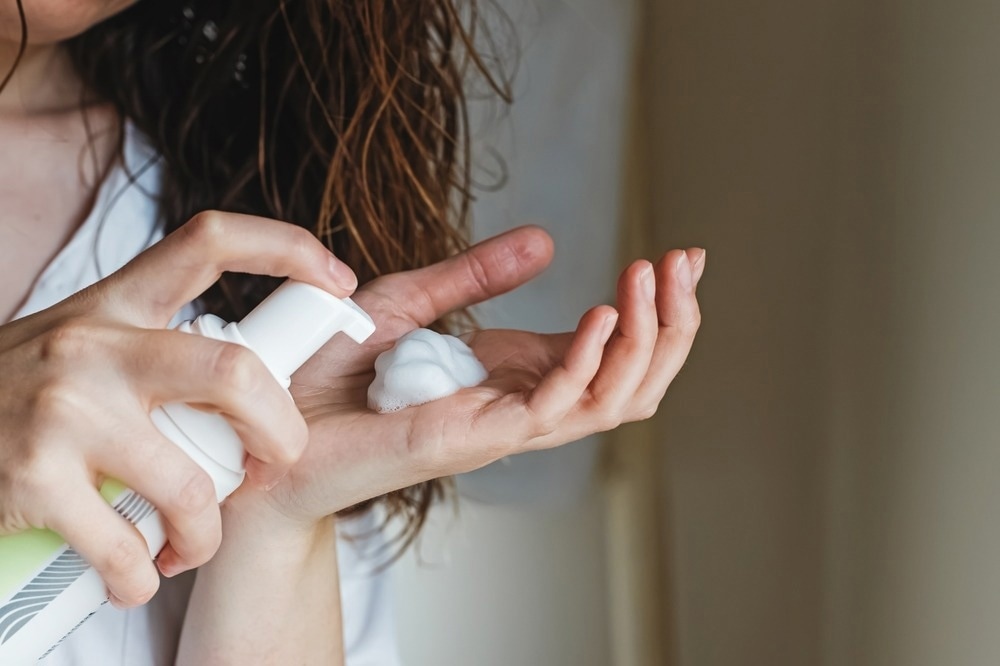In a recent study published in Environmental Science & Technology, researchers conducted realistic-type hair care experiments to assess cyclic volatile methyl siloxane (cVMS) emissions and exposures during hair care product (HCP) use in a residential structure.
 Study: Siloxane Emissions and Exposures during the Use of Hair Care Products in Buildings. Image Credit: Chiociolla/Shutterstock.com
Study: Siloxane Emissions and Exposures during the Use of Hair Care Products in Buildings. Image Credit: Chiociolla/Shutterstock.com
HCPs include cVMS, which can harm the environment and human health. Studies have reported that cVMS can survive and bioaccumulate in aquatic creatures, causing liver and lung damage in mice. In addition, inhalation exposure from personal care products (PCPs) can harm laboratory animals' respiratory tracts, livers, and neurological systems. Environmental researchers have focused on wash-off goods, with few investigations addressing leave-on product exposure.
About the study
In the present study, researchers characterized indoor emissions, inhalation exposure, and siloxane and other volatile organic compound (VOC) transfers outdoors from indoor environments during hair care activities indoors.
The team used the Purdue Zero Energy Design Guidance for Engineers (zEDGE) Tiny House as a zero-energy, mechanically ventilated architectural engineering laboratory to simulate realistic hair care environments. The team evaluated HCPs containing siloxane using popular hairstyle procedures such as straightening, curling, waving, and oiling. They integrated indoor, real-time volatile organic compound emission data with material balance modeling to assess the effects of hair care product types, hair styling equipment, operating temperature, and the length of hair on VOC and cVMS emission factors (EFs),
The researchers used ductless and single-zone cooling-heating systems with portable air conditioners to maintain 20 °C interior temperature. Variable-speed motorized ventilators with two filters [minimum efficiency reporting value (MERV) 13] filtered and directed outdoor air into the zEDGE's interior, whereas variable-speed exhaust fans in the bathroom transferred indoor air outside.
The team installed four fans on the loft and main floor of zEDGE to increase interior air mixing and performed proton-transfer-reaction time-of-flight mass spectrometry (PTR-TOF-MS) to detect VOC concentrations. The pressure was maintained at 2.20 mbar, temperature at 70 °C, and voltage at 600 V.
The team developed an automated system for valve sampling that switched between indoor and outdoor sample locations, sampling outdoors and indoors for five minutes and 55 minutes, respectively. They fitted polytetrafluoroethylene (PTFE) membrane filters at the sample line's input to eliminate particulates and calibrated monoterpenes and D5 with limonene gas and D5 standards, respectively.
The three types of experiments conducted over the two-month zEDGE campaign were realistic hair care-related experiments, realistic hair care regimen emission experiments, and four case studies with different HCP and hair styling tool combinations. The interior air was purged at an outside air change rate (ACR) of 9.0 h-1 for at least 30 minutes between trials to assist in eliminating indoor air contaminants. EFs produced from realistic experiments in the zEDGE Tiny House were then used to estimate indoor-to-outdoor VOC mass fluxes and inhalation exposures to VOCs during hair care regimens by material balance modeling of simulated bathrooms with and without exhaust fans. The study included 18- to 65-year-olds who used HCPs and styling products to mimic their habits.
Results
HCPs greatly influenced the indoor chemical content, with cVMS (decamethylcyclopentasiloxane) being the most dominant EF during the activities related to hair care. Hair length, HCP type, style of equipment, and operating temperatures impacted EFs. High styling temperatures and the large surface area provided by hair increased VOC emission.
Elevating hair straightening temperatures from ambient temperature to 210°C increased the emission factor of cVMS by 31% to 50%. Increased cVMS concentrations in indoor settings could significantly transfer cVMS outdoors through ventilation. In the PTR-TOF-MS analysis, the mass spectrum increased during active HCP usage. The real-time siloxane measurements showed that HCP use could supply siloxanes to outdoor and indoor environments and increase siloxane exposures among households.
In comparison to the baseline time with two inhabitants within zEDGE, more than 100 ions showed a 100% increase during hair care procedures. These ions were fragment ions, parent ions, or water clusters, with 75% having an m/z above 200. While zEDGE was unoccupied, siloxane concentrations during HCP use were 330- to 2300-fold greater than background values.
Siloxane emissions were mostly related to cVMS, with lVMS concentrations being much lower. cVMS concentrations were significantly higher while performing hair care activities than average indoor values. After the tests, participant-normalized cVMS concentrations were equivalent to or greater than peak values reported following PCP administration in a multi-occupant residential dwelling.
Hair straightening also enhanced the amounts of cVMS and monoterpenes. The long, steady, and tight contact between hair straighteners and the hair could aid in the evaporation of the HCPs applied to the hair, which might explain the stable emission patterns observed. VOCs with high EFs, such as monoterpenes, monoterpenoids, and propylene glycol, were detected during most hair care events. Product G emitted the most monoterpene and monoterpenoid EFs, equivalent to botanical disinfectants' monoterpene EFs. Propylene glycol (550 mg/individual) dominated product E emissions.
Conclusion
Overall, the study findings showed that HCPs can increase cVMS concentration in urban environments. Outdoor exposure triggers hydroxyl radical reactions, generates oxidation products such as siloxane, and contributes to secondary organic aerosol development. Indoor cVMS oxidation is less significant due to low OH concentrations. An improved understanding of customer behavior is crucial.
Journal reference:
- Jiang, J., Ding, X., Patra, S. S., Cross, J. N., Huang, C., Kumar, V., Price, P., Reidy, E. K., Tasoglou, A., Huber, H., Stevens, P. S., Boor, B. E. and Jung, N. (2023) Environmental Science & Technology. doi: 10.1021/acs.est.3c05156. https://pubs.acs.org/doi/full/10.1021/acs.est.3c05156